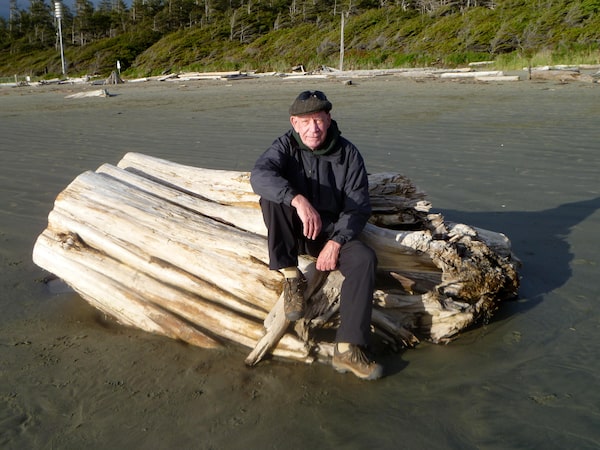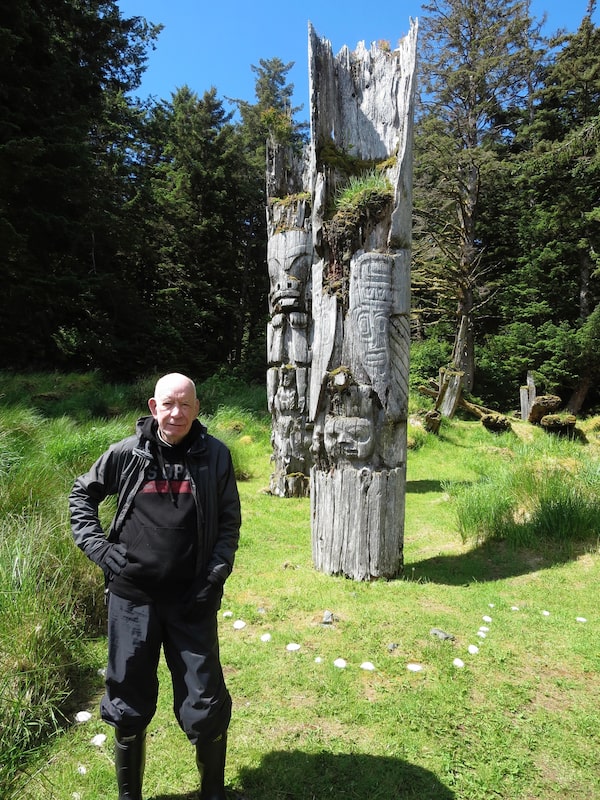
Tom Lee, who died in Victoria on Feb. 3 at the age of 79, was modest, soft-spoken, a careful listener and an inspiring speaker.Terry Lee/Supplied
When Canada began creating national parks in the Arctic in the final decades of the last millennium, Indigenous peoples were no longer treated like unwelcome intruders, as they had been during the creation of Banff and many of Canada’s other best known national parks. In Riding Mountain National Park in Manitoba, for example, in 1936 members of the Keeseekoowenin Ojibwa band were expelled and saw their houses and barns set alight by park wardens to ensure they did not return. But in the Arctic, park proposals became part of land claims settlements and Indigenous peoples demanded that they be co-managers of the new parks.
“It was a new world,” recalls Bruce Amos, who was then responsible for the development of new national parks. So when Tom Lee assumed the leadership of Parks Canada in 1993, “he took the lessons we were learning in the Arctic and applied them to the old parks. He directed all the park managers to start building relationships with neighbouring Aboriginal groups.”
This was the start of an important reconciliation process that has since become widespread public policy.
The Haida had been working with Parks Canada before Mr. Lee took over but they were at an impasse, according to Guujaaw, former president of the Haida Nation in B.C., who worked with Mr. Lee and his colleagues on the creation of Gwaii Haanas National Park Reserve and Haida Heritage Site.
“They were coming into our scene and we said we want to be able to continue fishing and hunting and we want to co-manage the park and we want our cultural heritage recognized. But they said those things were out of the question. They were stuck in the old ways. A bunch of Smokey Bears. Tom came in and changed all that. He was open to our ideas.”
Mr. Lee, who died in Victoria on Feb. 3 at the age of 79, was modest, soft-spoken, a careful listener and an inspiring speaker. He had a deft grasp of the art of moving the machinery of government. In addition to championing the role of Indigenous people in conservation efforts and park management, he led Parks Canada’s transition in 1999 to its current status as a special operating agency.

Mr. Lee led Parks Canada’s transition in 1999 to its current status as a special operating agency.Terry Lee/Supplied
Originally established in 1911 as the Dominion Parks Branch under the Department of the Interior, Parks Canada was the world’s first national park service. But over the years it had been shuffled around the federal bureaucracy, from the Department of the Interior to the Department of Indian and Northern Affairs, the Department of the Environment, and the Department of Canadian Heritage. Its priorities shifted just as frequently, and in 1993 it faced an uncertain future, with the government proposing that it be dismantled as a distinct entity.
“Tom was largely responsible for leading the drive to create the Parks Canada Agency, thus saving it from oblivion,” Mr. Amos said.
Mr. Lee served as the Parks Canada Agency’s CEO until his retirement in 2002. He transformed the agency’s work in collaborative management, conservation and use of protected places with Indigenous Peoples. He established new models for direct co-operation with Indigenous communities and groups in the stewardship and use of national heritage places. He guided the development and passage of the Canada National Parks Act in 2000, and the National Marine Conservation Areas Act in 2002. And he established the Parks Canada Charter, which focuses the agency’s attention on its core mandate to conserve natural and cultural heritage places for present and future generations.
During his nine-year tenure, 139 national historic sites, five national parks and one national marine conservation area were added to the Parks Canada network of heritage places.
In a tribute to Mr. Lee during a recent online memorial, Ron Hallman, the current CEO of Parks Canada, said, “Tom will be remembered as the father of the Parks Canada Agency. He was the architect of so many of the foundational pieces on which our organization rests, and the goals to which we aspire.”
Thomas (Tom) E.H. Lee was born Dec. 3, 1941, and raised on a 100-acre farm near Barrie, Ont., roughly 100 kilometres north of Toronto. His mother, Isabella, ran the farm, which belonged to her parents, John R. Hunter and Lorna (née Hardy) Hunter. Mr. Hunter was a battlefield veteran of the First World War who suffered from shrapnel wounds that limited his ability to help with the chores. Isabella Hunter married Tom Lee, the son of a neighbouring family. Mr. Lee enlisted in the Royal Canadian Air Force soon after the outbreak of Second World War. The young family was moved to RCAF Station Mont-Joli on the banks of the St. Lawrence River in Quebec for his training. Shortly after, he was killed in a training accident, leaving Ms. Lee with two small children, Sharon and Tom Junior, and another in her womb.
“I was three at the time and the eldest,” Mr. Lee’s sister, Sharon Bond, recalled. “So Mom moved us back to her parents’ farm. We grew potatoes and grain and had a big garden. We had horses and a few cows and pigs. For many years, we didn’t even have a tractor or a car.”
Ms. Bond said her brother played hockey, baseball and football, but it was music that became his passion. He played tuba in the school band, which, he once told his hometown newspaper, Barrie Today, was then one of the best in Canada.
“I travelled the world with them. The band kept me in school, it’s that simple. Otherwise, I probably would’ve ended up back on the farm.”
Mr. Lee married his high school sweetheart, Terry McKnight, and received a bursary from the Education Assistance Program, available for children of a serving member killed in wartime, to attend McMaster University in Hamilton. He completed a BA and a degree in physical education, and planned to become a physical education teacher. He did teach for a year but became enamoured with the ideas of Charles Brightbill, a professor at the University of Illinois who was a leading thinker on the benefits of recreation. Mr. Lee applied to study under Prof. Brightbill.
He was accepted, and his wife recalled, “Off we went with our young daughter, Tanya, in a brand-new Mustang convertible, which the bank owned, to Champaign-Urbana.” On arrival, Mr. Lee discovered that Prof. Brightbill had died but he decided to remain and complete his studies in recreation.
A year later, they were back in Canada, where he landed a job with the Ontario government working on park planning. He remained with Ontario Parks for 10 years before moving to British Columbia where he spent 17 years in the B.C. government’s parks department and three years with the Canadian Forest Service. By the time he was offered a position with Parks Canada in Ottawa, he had helped plan and develop parks in both provinces.
Family vacations, both his children recall, were “tents, sleeping bags” and adventures in dunes in the Maritimes, the Bruce Peninsula in Ontario, the forests of Jasper National Park, the B.C.’s Pacific Rim National Park and many landscapes in between.
Ms. Lee recalls camping holidays where she and the children “swam while Tom sat at a picnic table in front of papers being held down by rocks, having people dropping by for meetings.”
In retirement, music and travel with his wife were constants.
“He played guitar and, whenever he travelled, he always came back with a new instrument – drums, flutes. At the cottage he had a mandolin and banjo. When the grandkids came to visit, he would write songs and get them playing music with him,” his son recalls.
He leaves his wife, Terry, his two children, Tanya Lee and Tom Lee, their partners, four grandchildren and extended family.
Mr. Lee never lost his awe of Canada’s natural landscapes or his gift for a poetic turn of phrase. He once wrote of his memories of “white seagulls on brown farm furrows, stone boats and old coats, barn swallows and pond wallows, red pin cherries and ripe raspberries” of his childhood farm. He believed that you could hear Canada’s “voices in its nature – a thundering waterfall, the cry of the osprey, the trembling of an aspen.”
He was also an inspiring storyteller, Mr. Amos says. At the first meeting he attended where Mr. Lee spoke, the new boss of Parks Canada “stepped up to the podium with a few scribbled notes, started by saying, ‘I want to paint you a picture of Canada …’ and proceeded to cross the country with stories of art, music, books, places, history and people. He left his audience, and himself, in tears.”
In recognition of his contributions as a public servant and for his conservation of Canada’s natural resources, Mr. Lee was named an officer of the Order of Canada in 2019.
His colleagues say Mr. Lee’s vision for Canada’s parks and the work he did to bring that vision to fruition will be felt for decades to come.
“Tom’s passion, insight and exemplary leadership changed Canada and Canadians in ways that are profound and will echo down the generations to come,” wrote John Thomson, Parks Canada director of an upcoming international congress on marine protected areas. “We are only now beginning to fully appreciate how much his legacy inspires us and informs our work. History will see his career as a watershed that was a precursor to a new and better Canada that cherished its heritage and respected its Indigenous peoples.”